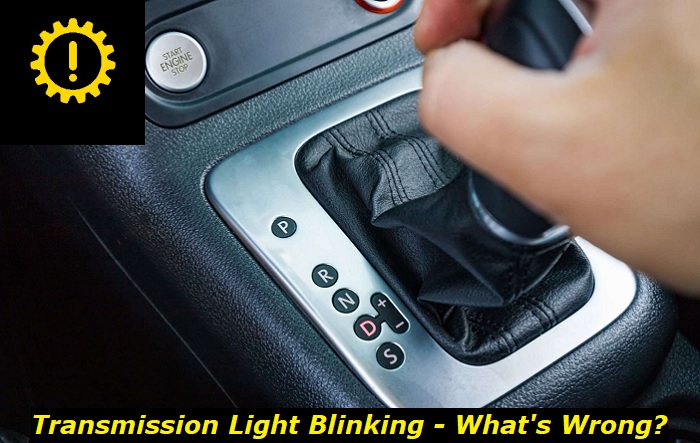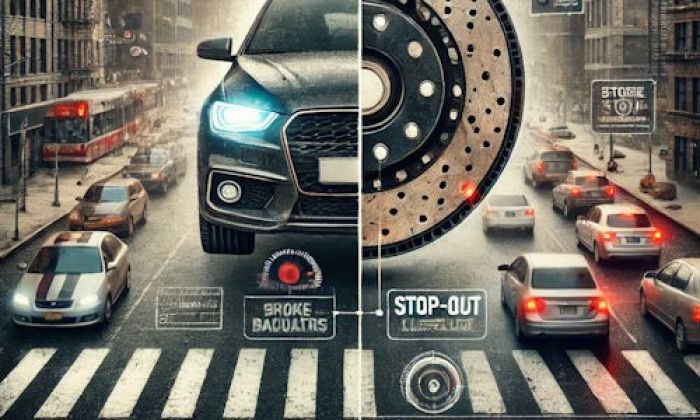Sometimes it begins with a rattling sound, then your transmission light starts to blink, followed by a slight smell of something burning. Whether or not this picture describes your exact situation, transmission problems can be way too easy to identify.
Transmission warning light highlights
- Common reasons:issues with the transmission or transmission control module
- How to fix:get the car towed to the dealership or repair shop
- Possible consequences:transmission may break
- Priority level:High
- Can you drive?Not recommended
- DIY repair:Impossible
- Repair price range:$300-$4,500

What Does the Transmission Light Do?
When you're behind the wheel, there are a lot of different lights and indicators that you need to pay attention to. One of the most important is the transmission light, also known as the gear indicator. This light lets you know when there's a problem with your transmission, and it can be a crucial warning sign that something is wrong with your vehicle.
The transmission light is a warning signal triggered by your car's computer system. It is connected to several sensors and switches that monitor the performance of your transmission. When one of these sensors or switches detects a problem, it sends a signal to the computer, which then activates the transmission light.
There are a variety of different colors and shapes that a transmission light can take, depending on the make and model of your vehicle. Some cars will have a simple red light that comes on when there's a problem, while others may have a more detailed display that shows the specific gear that's causing the issue.
The important thing is to be able to identify what's causing the light to blink, and whether or not the vehicle would need professional servicing.
Blinking Transmission Light- What Causes this?
A blinking transmission light can be a worrying sight for any car owner. It is a sign that something is not right with your vehicle's transmission and immediate attention is required. However, before panicking, understand the common causes of a blinking transmission light and what steps you can take to fix the issue.
Here are some typical causes of a blinking transmission light:
- Low transmission fluid levels:
The transmission relies on a certain level of fluid to function properly. If the fluid level is too low, the transmission will not be able to operate correctly and the light will blink as a warning. This can be caused by a leak, a malfunctioning transmission cooler, or not checking and topping off the fluid level regularly.
- Faulty transmission sensors:
The transmission has several sensors that monitor its performance and send signals to the transmission control module. If one or more of these sensors malfunction, the transmission may not be able to shift gears properly and the light will blink.
- Clogged transmission filter:
The transmission filter removes any debris or contaminants from the fluid, which can cause damage to the transmission if not removed. If the filter becomes clogged, this can affect the proper functioning of the transmission.
- Worn or damaged transmission components:
The transmission has many moving parts that can wear out over time, such as gears, bearings, and clutches. When this happens, the transmission may malfunction, causing the light to blink.
- Electrical issues with the transmission control module:
This is the part that controls the transmission's operation. If there is an electrical issue with the module, such as a short circuit or loose connection, the transmission becomes affected.
Diagnosis And Troubleshooting a Blinking Transmission Light
With a little bit of knowledge and following simple steps, you can diagnose and troubleshoot the issue with ease.
- Step 1:
The first step in diagnosing a blinking transmission light is to check the transmission fluid levels. A low fluid level can cause a variety of problems with your transmission, including slipping gears and difficulty shifting. To check the fluid level, simply locate the transmission dipstick and check to make sure that the fluid is at the proper level. If it's low, add more fluid until it reaches the recommended level.
- Step 2:
Next, check for any error codes that may be stored in the transmission control module. These codes can help you identify the specific issue causing the light to blink. You can access these codes by using a diagnostic scanner tool, which you can buy or borrow from an auto parts store.
- Step 3:
Once you have identified the specific error code, you can then start to troubleshoot the issue. For example, if the code indicates a problem with the transmission sensor, you will need to replace the sensor. If the code indicates a problem with the transmission itself, then you will need to take your car to a transmission specialist for further diagnosis and repair.
In some cases, a blinking transmission light can also be caused by a problem with the transmission control module. If this is the case, you will need to replace the module. This can be a more complex and costly repair, but it is essential to get your transmission working fine again.
- Step 4:
Finally, it's a good idea to perform a road test to check the vehicle's transmission performance. This will give you a sense of how the transmission is working and whether or not any issues need to be addressed. If you notice any problems with shifting or slipping gears, take your vehicle to a mechanic for further diagnosis and repair.
Symptoms of a Faulty Transmission
Transmission issues can be a major headache for car owners as they can be costly to repair and may even leave you stranded on the side of the road.
The good news is that there are often warning signs that something is wrong with your transmission, so you can address the problem before it becomes a major issue. Aside from a blinking transmission light, here are some common symptoms of a faulty transmission:
- Slipping gears: If you notice that your car is shifting gears on its own or that it seems to be slipping out of gear, this could be a sign of a transmission problem. This can happen when the transmission fluid is low or dirty, or when the gears themselves are worn out.
- Delay in shifting:Your car may also take longer than usual to shift gears when the transmission is faulty. Low transmission fluid or a problem with the transmission control module are the main causes here.
- Grinding or whining noises: If you hear strange noises coming from your car when you shift gears, this could be a sign of a transmission issue. Worn gears or a damaged clutch could be causing the noise.
- Burning smell: Some drivers notice a burning smell coming from their car before a transmission breakdown. An overheating transmission is often to blame here. This can happen when there is a problem with the transmission cooler.
Driving With a Blinking Transmission Light
Knowing what to do when this blinking light appears on your dashboard can be difficult. You become unsure of whether or not to continue driving.
As you now understand, a blinking transmission light is a warning that something is wrong with your vehicle's transmission. This could be something as simple as a low transmission fluid level, or something more serious like a transmission problem.
If the problem is something simple, like a low transmission fluid level, then you may be able to continue driving your vehicle. However, with a more serious problem, it's best to avoid driving your vehicle until it is fixed.
One of the most important things to remember is that continuing to drive your vehicle with a blinking transmission light can cause further damage to your transmission. This can lead to costly repairs and can even put you and your passengers at risk.
So, what should you do if you see a blinking transmission light? The best course of action is to pull over and turn off your vehicle as soon as possible. If you're unable to safely pull over, turn on your hazard lights and proceed to the nearest safe location.
Conclusion
The blinking transmission light on your vehicle is a crucial indicator that you should not ignore. It is the first sign that something is amiss with your transmission system, so, address it as soon as possible. Ignoring this warning could lead to costly repairs and even complete transmission failure.
It is always best to take your vehicle to a qualified mechanic for a proper diagnosis and repair. Remember, the blinking transmission light is there to protect your vehicle and your wallet. Keep an eye on it and take action when necessary, to ensure a smooth and safe ride for many miles to come.
About the authors
The CarAraC research team is composed of seasoned auto mechanics and automotive industry professionals, including individuals with advanced degrees and certifications in their field. Our team members boast prestigious credentials, reflecting their extensive knowledge and skills. These qualifications include: IMI: Institute of the Motor Industry, ASE-Certified Master Automobile Technicians; Coventry University, Graduate of MA in Automotive Journalism; Politecnico di Torino, Italy, MS Automotive Engineering; Ss. Cyril and Methodius University in Skopje, Mechanical University in Skopje; TOC Automotive College; DHA Suffa University, Department of Mechanical Engineering






Add comment